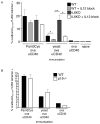IL-6-inducing whole yeast-based immunotherapy directly controls IL-12-dependent CD8 T-cell responses
- PMID: 22130158
- PMCID: PMC3241875
- DOI: 10.1097/CJI.0b013e3182356888
IL-6-inducing whole yeast-based immunotherapy directly controls IL-12-dependent CD8 T-cell responses
Abstract
In current clinical trails, whole yeast-based immunotherapy expressing hepatitis C viral antigens demonstrated statistically significant improvement in end of treatment responses when combined with type I interferon based standard of care, even in standard of care resistant patients. Although preclinical data suggest yeast vaccination, such as type I interferon, facilitates CD8 T-cell immunity, the capacity of yeast to generate immunity in patients resistant to type I interferon calls into question the mechanism(s) underpinning the efficacy of this approach. We show yeast and a Toll-like receptor exclusive agonist, Pam3Cys, differ in CD8 T-cell generation when combined with an agonistic CD40 antibody. Although both yeast and PamCys were largely Toll-like receptor dependent, the primary CD8 response generated by yeast was significantly less than Pam3Cys in wild-type hosts even in a CD4 T-cell-deficient setting. In addition, immunization of IL6 mice with yeast produced a 3-fold to 6-fold increased CD8 response while the Pam3Cys response was unaffected. The yeast but not Pam3Cys-driven CD8 response was inhibited in both wild-type and IL-6 hosts by blocking interleukin (IL)-12. In addition, IL6 mice had increased CD86 expression on their dendritic cells after yeast immunization also inhibited by IL-12 blockade. Collectively, our results indicate the CD8 T-cell response to yeast but not Pam3Cys is influenced by IL-6-mediated control of IL-12 critical for dendritic cell activation. To our knowledge this is the first demonstration that yeast directly influence IL-12-associated CD8 T-cell immunity providing an additional route whereby recombinant yeast may provide efficacy independent of type I interferon.
Figures







Similar articles
-
IL-2 is required for the activation of memory CD8+ T cells via antigen cross-presentation.J Immunol. 2006 Jun 15;176(12):7288-300. doi: 10.4049/jimmunol.176.12.7288. J Immunol. 2006. PMID: 16751372
-
Type I IFN-induced, NKT cell-mediated negative control of CD8 T cell priming by dendritic cells.J Immunol. 2008 Aug 1;181(3):1633-43. doi: 10.4049/jimmunol.181.3.1633. J Immunol. 2008. PMID: 18641299
-
Induction of CD70 on dendritic cells through CD40 or TLR stimulation contributes to the development of CD8+ T cell responses in the absence of CD4+ T cells.J Immunol. 2005 Jan 15;174(2):710-7. doi: 10.4049/jimmunol.174.2.710. J Immunol. 2005. PMID: 15634890
-
Dendritic cells activated by an anti-inflammatory agent induce CD4(+) T helper type 2 responses without impairing CD8(+) memory and effector cytotoxic T-lymphocyte responses.Immunology. 2010 Mar;129(3):406-17. doi: 10.1111/j.1365-2567.2009.03193.x. Epub 2009 Nov 16. Immunology. 2010. PMID: 19922421 Free PMC article.
-
Cutting edge: a critical role for CD70 in CD8 T cell priming by CD40-licensed APCs.J Immunol. 2004 Dec 1;173(11):6542-6. doi: 10.4049/jimmunol.173.11.6542. J Immunol. 2004. PMID: 15557144
Cited by
-
A whole recombinant yeast-based therapeutic vaccine elicits HBV X, S and Core specific T cells in mice and activates human T cells recognizing epitopes linked to viral clearance.PLoS One. 2014 Jul 22;9(7):e101904. doi: 10.1371/journal.pone.0101904. eCollection 2014. PLoS One. 2014. PMID: 25051027 Free PMC article.
-
PD-L1 Reverse Signaling in Dermal Dendritic Cells Promotes Dendritic Cell Migration Required for Skin Immunity.Cell Rep. 2020 Oct 13;33(2):108258. doi: 10.1016/j.celrep.2020.108258. Cell Rep. 2020. PMID: 33053342 Free PMC article.
-
Antigen capture and archiving by lymphatic endothelial cells following vaccination or viral infection.Nat Commun. 2014 Jun 6;5:3989. doi: 10.1038/ncomms4989. Nat Commun. 2014. PMID: 24905362 Free PMC article.
-
Phenotype and function of protective, CD4-independent CD8 T cell memory.Immunol Res. 2013 Mar;55(1-3):135-45. doi: 10.1007/s12026-012-8356-9. Immunol Res. 2013. PMID: 22948808 Free PMC article.
-
Molecular tracking devices quantify antigen distribution and archiving in the murine lymph node.Elife. 2021 Apr 12;10:e62781. doi: 10.7554/eLife.62781. Elife. 2021. PMID: 33843587 Free PMC article.
References
-
- Sanchez PJ, McWilliams JA, Haluszczak C, et al. Combined TLR/CD40 stimulation mediates potent cellular immunity by regulating dendritic cell expression of CD70 in vivo. J Immunol. 2007;178:1564–1572. - PubMed
Publication types
MeSH terms
Substances
Grants and funding
LinkOut - more resources
Full Text Sources
Other Literature Sources
Research Materials

